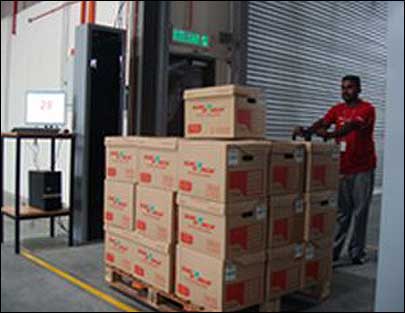A Malaysian records-management company is employing radio frequency identification to track more than 1 million paper documents and 500,000 cartons.
Sure-Reach, which stores its clients’ records, is using ultrahigh-frequency (UHF) EPC Gen 2 tags at its warehouse in Shah Alam, near Kuala Lumpur, to track the documents throughout the facility, and to improve the process of taking inventory.

Peter Chan, Sure-Reach’s group managing director, says the company’s particular implementation of RFID is a first in the records-management industry, and ensures best practice for its customers. “We understand that there is currently no records-management company in the world that has implemented RFID up to the individual document level,” he states. “With RFID, any movement of boxes or documents moving in and out of our warehouse is accounted for automatically, without the need for any manual scanning.”
By using RFID, Chan explains, Sure-Reach will be able to perform an inventory of all documents in boxes and individual files in a matter of weeks, rather than months. It will also allow the company to track and trace records throughout its warehouse, as well as improve the efficiency of its operations.
Sure-Reach chose Hewlett-Packard (HP) to roll out the RFID system. HP’s Asia Pacific regional manager, Tim Wilkinson, says the Shah Alam warehouse began operating in June 2008, and that HP installed the complete RFID system in September.
Four doorway portals, each containing two Omron RFID interrogators, were installed at the warehouse. In addition, two inventory carts, custom-built locally for Sure-Reach, were provided to scan the tags of cartons and documents located on shelves.
“All the portals are connected on the Sure-Reach network, and communicate tag reads in real time,” Wilkinson says. “As cartons or documents pass through the portals, Microsoft BizTalk middleware communicates with the back-end O’Neil record-management software to validate what is being tracked.”
If a tag is recognized, the back-end system is automatically updated with the new location of the corresponding item or carton. Feedback is then provided to the operators through screens at each portal.
The inventory carts work on a standalone system that is fully mobile, enabling operators to move around the warehouse. After stock-taking is completed, the cart’s laptop is returned to the office and connected to the company’s network, in order to upload the new inventory data to record-management software.
“Currently,” Wilkinson says, “all cartons and documents have been tagged and tracked, with tags provided for 500,000 cartons and 1.1 million documents.”
Sure-Reach has attached UPM Raflatac‘s self-adhesive FlagTags labels to all individual documents in storage. Each FlagTag has a UPM Raflatac DogBone RFID inlay embedded, with the inlay’s antenna protruding perpendicularly from its surface to ensure that readability is not impaired by the material, or by the labeled item’s packaging. This is vital to ensure a 100 percent read rate, according to Edward Lu, UPM Raflatac’s Asian-Pacific sales and marketing director.
Sure-Reach also attaches UPM Raflatac DogBone tags to cartons, which are used to hold large quantities of documents and can then be stored on a shelf, three deep. A large number of RFID tags can be read simultaneously, without requiring a direct line of sight with the interrogator.
“There is a lot of potential growth for the use of RFID in records management,” Lu says, “because documents are simple to track. There are no mechanics or liquids to interfere with the signal, and it really is an ideal environment for RFID.”
Sure-Reach thoroughly tested the system ahead of its rollout. This included assessing the system’s ability to locate documents and boxes, conducting an inventory of some cartons and records, and tracking their movement into and out of the warehouse, as well as any unauthorized movement.
HP’s Wilkinson says Sure-Reach is already enjoying the benefits of RFID, with the time required to perform inventory reduced from months to mere weeks. Rather than having to remove every carton from a particular shelf to read a bar-coded label, the inventory cart is wheeled in front of the shelves, and all carton tags are read simultaneously.
What’s more, RFID has made it easier to receive and ship documents. Pallets containing tagged boxes from several customers are passed through an RFID scanner at the doorway, with each box identified individually. Incidents of misplaced documents due to human error have also been reduced.
“For the current system,” Wilkinson says, “there are already extensions underway to support tracking of tape media for data centers. Sure-Reach is extending its business portfolio to include tape management, as many organizations are required to store their tapes offsite for audit purposes.” In addition, he notes, Sure-Reach is planning to open a warehouse in East Malaysia in the coming years, and expects to use RFID there as well.
Sure-Reach’s Chan is reluctant to reveal the amount the company spent to implement the RFID system at its Shah Alam warehouse, though he says it was significant. However, he notes, while it is still too early to determine the return on investment from the system, it would make the company more efficient and provide it with better control over clients’ documents through improved accuracy and reliability.
“It will allow us to have a leading and competitive edge to secure clients that would want records-management services,” Chan says.
Although Sure-Reach claims it is the first records-management company to tag individual documents, it is not the first to use radio frequency identification. In February 2007, Recall Corp. deployed an RFID system enabling it to track document cartons at its storage facility in Northboro, Mass. And in November 2008, the company announced it was rolling out a similar system at its warehouses in Australia.

